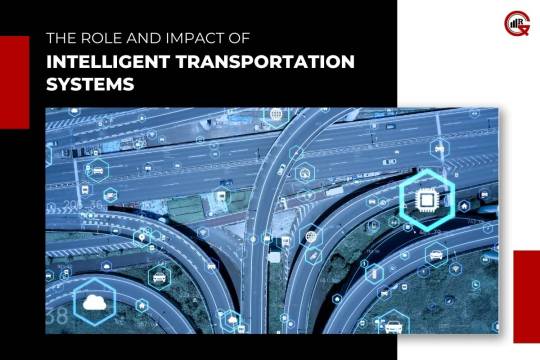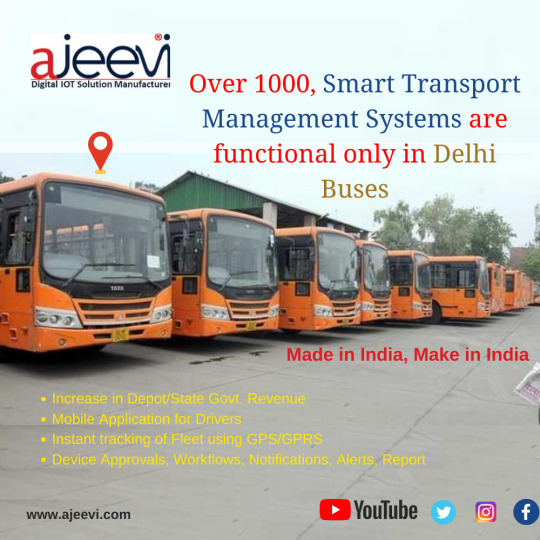#IntelligentTransportationSystems
Explore tagged Tumblr posts
Text
The Role And Impact Of Intelligent Transportation Systems

In today’s fast-paced world, transportation systems are evolving at a rapid pace, driven by technological advancements and the growing need for efficient, sustainable, and safe mobility solutions. Among the key innovations shaping the future of transportation is the development and implementation of Intelligent Transportation Systems (ITS). These sophisticated systems harness cutting-edge technologies to optimize traffic flow, enhance safety, reduce congestion, and improve overall transportation efficiency. In this article, we explore the concept, components, benefits, challenges, and prospects of Intelligent Transportation Systems.
Understanding Intelligent Transportation Systems
ITS encompasses a wide range of technologies, applications, and services designed to improve the efficiency, safety, and sustainability of transportation networks. ITS integrates advanced information and communication technologies with transportation infrastructure, vehicles, and travelers to enable smarter, more connected, and data-driven transportation solutions.
Components of Intelligent Transportation Systems
Traffic Management Systems: Traffic management systems use real-time data collection, analysis, and control strategies to monitor and manage traffic flow on roadways, highways, and urban streets. These systems may include traffic surveillance cameras, traffic signal control systems, dynamic message signs, and adaptive traffic signal control algorithms to optimize traffic flow and reduce congestion.
Vehicle-to-Infrastructure (V2I) Communication: Vehicle-to-Infrastructure communication enables vehicles to exchange data with roadside infrastructure, such as traffic signals, road signs, and toll booths, to receive real-time traffic information, navigation assistance, and safety warnings. V2I communication facilitates intelligent routing, collision avoidance, and emergency response coordination to enhance driver safety and efficiency.
Vehicle-to-Vehicle (V2V) Communication: Vehicle-to-Vehicle communication allows vehicles to communicate with each other to share information about their speed, position, and trajectory, enabling cooperative driving and collision avoidance maneuvers. V2V communication systems use wireless communication technologies, such as Dedicated Short-Range Communication (DSRC) or Cellular Vehicle-to-Everything (C-V2X), to enable real-time data exchange between vehicles.

Traveler Information Systems: Traveler information systems deliver real-time traffic updates, road conditions, and travel advisories to travelers through various channels, such as mobile apps, websites, variable message signs, and roadside information displays. These systems help travelers make informed decisions about their routes, modes of transportation, and travel schedules to avoid congestion and delays.
Benefits of Intelligent Transportation Systems
Improved Traffic Flow: Intelligent Transportation Systems help optimize traffic flow, reduce congestion, and minimize travel times by providing real-time traffic information, dynamic routing recommendations, and adaptive traffic signal control strategies.
Enhanced Safety: By facilitating vehicle-to-vehicle and vehicle-to-infrastructure communication, ITS systems enable proactive safety measures, collision avoidance maneuvers, and emergency response coordination to reduce the risk of accidents and improve overall road safety.
Environmental Sustainability: ITS contributes to environmental sustainability by reducing fuel consumption, vehicle emissions, and environmental pollution through more efficient traffic management, optimized vehicle routing, and reduced congestion.
Enhanced Mobility and Accessibility: ITS improves mobility and accessibility for all travelers, including motorists, cyclists, pedestrians, and public transportation users, by providing real-time travel information, accessible transportation options, and inclusive design features.
Cost Savings and Economic Benefits: By reducing travel times, fuel consumption, and vehicle operating costs, ITS systems generate cost savings for businesses, individuals, and governments while stimulating economic growth, productivity, and competitiveness in urban and regional economies.
Challenges and Considerations

Privacy and Security Concerns: ITS involves the collection, processing, and transmission of large volumes of data, raising concerns about privacy, cybersecurity, and data protection. Safeguarding sensitive information and ensuring secure communication networks are essential to maintain public trust and confidence in ITS systems.
Equity and Accessibility: Ensuring equitable access to Intelligent Transportation Systems for all travelers, including underserved communities, low-income individuals, and persons with disabilities, requires addressing barriers to adoption, affordability, and digital literacy while promoting inclusive design and user-friendly interfaces.
Regulatory and Legal Frameworks: The development and deployment of ITS require clear regulatory frameworks, standards, and guidelines to address legal and liability issues, data ownership rights, and compliance with privacy regulations and transportation laws.
Interagency Collaboration: Successful implementation of Intelligent Transportation Systems relies on collaboration and coordination among multiple stakeholders, including government agencies, transportation authorities, private sector partners, and technology providers, to align goals, share resources, and address interoperability challenges.
Future Trends and Innovations
Autonomous Vehicles: The advent of autonomous vehicles (AVs) promises to revolutionize transportation systems by integrating self-driving technologies with Intelligent Transportation Systems to enable safer, more efficient, and sustainable mobility solutions.
Connected Infrastructure: The deployment of connected infrastructure, such as smart intersections, sensor-equipped roadways, and dynamic lane markings, enhances the capabilities of ITS by providing real-time data insights, predictive analytics, and proactive traffic management strategies.
https://gqresearch.com/wp-content/uploads/2024/04/2.3-Mobility-as-a-Service-MaaS.jpg
Big Data Analytics: The use of big data analytics, artificial intelligence, and machine learning techniques enables ITS to analyze vast amounts of transportation data, identify patterns, and generate actionable insights to optimize traffic flow, predict demand, and improve decision-making.
Smart Cities Integration: ITS is increasingly integrated with broader smart city initiatives, such as smart energy grids, environmental monitoring systems, and digital infrastructure, to create holistic, interconnected urban ecosystems that enhance livability, sustainability, and resilience.
Conclusion: Shaping the Future of Transportation
In conclusion, Intelligent Transportation Systems represent a transformative approach to addressing the complex challenges facing modern transportation systems. By harnessing advanced technologies, data-driven strategies, and collaborative partnerships, ITS enables smarter, safer, and more efficient mobility solutions that enhance quality of life, promote economic prosperity, and protect the environment for current and future generations. As we continue to navigate the complexities of urbanization, population growth, and technological innovation, Intelligent Transportation Systems will play an increasingly critical role in shaping the future of transportation and shaping the way we move, connect, and thrive in an ever-changing world.
#intelligenttransportationsystems#smartmobility#futureoftransportation#trafficmanagement#connectedinfrastructure
0 notes
Text
Video Analysis Solutions
AvidBeam offers innovative Video Analysis Solutions for face recognition, traffic violation, license plate recognition, behavior analysis, and anomaly detection.
AvidBeam® is an AI video analytics company that pushes the boundaries of video processing capabilities with big data distributed architecture. Its expertise in computer vision, deep learning, visualization and neural networks enable AvidBeam® to offer scalable video analytics solutions for security, safety and business intelligence applications to its customers. AvidBeam team delivers video processing and analytics products cutting across various verticals and geographies including Smart Cities, Smart Retail, Transportation, Oil & Gas, Healthcare, Education, etc in the Middle East, Gulf and North America.Headquartered in the Netherlands with teams in the US, Egypt and Saudi Arabia.
Video Analysis Solutions
#videoanalyticsforhotels#videosurveillanceforhotels#hotelvideosurveillance#videosurveillancesolutionsforhotels#hotelsecuritysystemsolutions#videoanalysissolutions#videoaianalyticssolutions#videoanalysisplatform#videosurveillanceandanalysis#railwayvideosurveillancesolutions#videosurveillanceforrailway#videosurveillanceforsmartbuilding#intelligenttransportationsystem#videosurveillanceforoil&gas
0 notes
Photo

Ritornando a viaggiare all'estero per lavoro dopo 19 mesi.. un segno che le cose cambiano ! #europe #safety #citizenship #travel #europetravel #intelligenttransportationsystems #worldcongress #its #itswc21 #hamburg (presso Aeroporto di Firenze) https://www.instagram.com/p/CU18NBlqCjg/?utm_medium=tumblr
#europe#safety#citizenship#travel#europetravel#intelligenttransportationsystems#worldcongress#its#itswc21#hamburg
1 note
·
View note
Text
Revolutionizing Transportation: The Role of Artificial Intelligence
Revolutionizing Transportation: The Role of Artificial Intelligence in Transportation Industry is a groundbreaking book that delves deep into the rapidly evolving field of transportation technology. This book explores the transformative impact of artificial intelligence (AI) on various aspects of transportation, including autonomous vehicles, smart traffic management, and sustainable mobility. Written by a team of expert authors, Revolutionizing Transportation provides a comprehensive overview of the latest advances in AI technology and how they are being applied to transportation. The book covers a wide range of topics, from the basics of machine learning and data analytics to the practical implementation of AI solutions in real-world transportation scenarios.
#AIinTransportation#TransportationRevolution#SmartMobility#IntelligentTransportationSystems#ConnectedVehicles#AutonomousVehicles#MobilitySolutions#AIforTransportation#FutureofTransportation
0 notes
Text
Don't rely on safety systems in cars during bad weather

Vehicle safety systems have become increasingly sophisticated in recent years, utilizing advanced sensors, cameras, and artificial intelligence to prevent accidents and keep drivers safe. However, one major obstacle that safety systems still struggle to overcome is bad weather conditions. While safety systems such as collision detection and lane departure warnings are highly effective in normal weather conditions, heavy rain, snow, and fog can significantly reduce their effectiveness. This is because these weather conditions can obscure or distort the sensors' inputs, making it difficult for the systems to accurately detect and react to potential hazards. For example, in heavy rain or snow, cameras and lidar sensors may become obscured or blinded by water droplets or snowflakes, making it difficult for the system to accurately identify obstacles in the vehicle's path. Similarly, in foggy conditions, radar sensors may bounce off of water droplets in the air, leading to inaccurate readings. To overcome these challenges, manufacturers are working to develop new sensor technologies that are better suited to bad weather conditions. For example, some companies are developing radar systems that can adjust their frequency to better penetrate rain or fog. Others are experimenting with lidar sensors that use multiple wavelengths of light to better differentiate between water droplets and solid objects. Despite these advances, it is clear that vehicle safety systems still have a long way to go before they can reliably operate in all weather conditions. As such, it is important for drivers to remain vigilant and use caution when driving in bad weather, even if their vehicle is equipped with the latest safety technologies. In conclusion, while vehicle safety systems have come a long way in recent years, they still struggle to "see" in bad weather conditions. While manufacturers are working to develop new technologies to overcome these challenges, it is important for drivers to remain aware of the limitations of their vehicle's safety systems and take appropriate precautions when driving in challenging weather conditions. Read the full article
#adaptiveheadlights#advanceddriverassistancesystems#automotivesafetytechnology#autonomousemergencybraking#blindspotmonitoring#camera-baseddetection#infraredsensors#intelligenttransportationsystems#lanedeparturewarning#nightvision#radar-baseddetection#roadsafety#vehiclecollisionavoidancesystems#vehiclecrashprevention#vehicle-to-vehiclecommunication
0 notes
Text
Smart mobility market to reach $70.5 billion by 2027

Smart mobility market to reach $70.5 billion by 2027 According to Allied Market Research, implementation of on-demand transportation services and supportive government initiatives regarding Smart Cities will drive growth in the global market. #AlliedMarketResearch #Bosch #Cisco #Excelfore #Ford #InnovizTechnologies #IntelligentTransportationSystems #MAASGlobal #QuaLiXInformationSystem #Siemens #SmartCities #SmartMobility #TomTomInternational #Toyota #TransportationServices Read the full article
#AlliedMarketResearch#Bosch#Cisco#Excelfore#Ford#InnovizTechnologies#IntelligentTransportationSystems#MAASGlobal#QuaLiXInformationSystem#Siemens#SmartCities#SmartMobility#TomTomInternational#Toyota#TransportationServices
0 notes
Text


http://moverxpro360.com
We offer the best prices on the market for
the best software related services for Moving Companies!
#MoverXpro360#movingcompany#movingestimates#digitalinventory#Movingsales#movers#movingsoftware#movingcrm#storagesoftware#themovingcalculator#CRM#softwaredevelopment#appdesign#growyourbusiness#movingleads#movingbusinessadvice#movingbusiness#softwareasaservice#intelligenttransportationsystem#ITS#FreightSoftware#brokersfotware#moving company software#move software#moves software#smart move sotware"#MovingCompanySoftware#truckingsoftware#trucking#shippingsoftware
0 notes
Text
Intelligent Transportation System and Solution
Intelligent transportation solution provides real-time traffic statistics that helps in solving problems associated with traffic congestion. The system fetches information from sensors that analyze vehicle speed, pre-emption alarms, traffic signals, and other traffic-related data. Road safety and surveillance, traffic management, public transport, environment protection, freight management, automotive telematics, and parking management are some of the application areas of intelligent transportation solutions.
Growing concern regarding the public safety and increasing traffic congestion is driving the market growth of the intelligent transportation system. The growing need for effective traffic management in order to reduce the traffic is again fueling market growth. Moreover, the increasing adoption of the intelligent transportation system for real-time traffic information as it helps in resolving growing traffic congestion is also propelling the market growth of the intelligent transportation system. The growing focus of manufacturers to create awareness regarding traffic management will further favor market growth in the near future. For instance, in July 2020, Huawei conducted an online summit of the Intelligent Traffic Management Solution with the theme of "Transform the Way We Move” to address challenges on traffic law enforcement, traffic violation inspection, and traffic control with advanced technologies including big data, AI, cloud, 5G, and more.
From the geographical point of view, North America is expected to gain significant growth over the forecast period and this is attributed to the strong presence of IT & software companies coupled with the rapid adoption of intelligent transportation systems across the region. According to the International Trade Administration, the United States has the most advanced software and information technology (IT) services industry in the world. More than 40 percent of the $5 trillion global IT market is in North America, primarily the United States and there are more than 525,000 software and IT services companies in the United States and around 40,500 tech startups were established in 2018 alone.
Key Developments:
1. In June 2020, SINTRONES, a provider of computing technology in vehicles, announced the launch of the new ABOX-5210G. The new product is powered by AI GPU computing, Intel Gen 10 Core i9, with NVIDIA GPU technology and incorporates numerous unique features to support AIoT (AI and IoT) on Smart Cities and IIoT (Intelligent IoT) on Transportation.
2. In July 2020, NEC Technologies India, a wholly-owned subsidiary of Japanese technology company NEC Corporation, has partnered with Urban Mass Transit Company (UMTC) to develop intelligent mobility solutions in rural and urban India.
3. In April 2020, FITSCO (Shanghai Fuxin Intelligent Transportation Solutions Co.) and Cognitive Pilot, have signed a contract to develop an AI-based computer vision system for urban trams with the possibility of autonomous control and movement.
#Intelligenttransportationsolution#intelligenttransportationsystem#Roadsafetyandsurveillance#trafficmanagement#publictransport#environmentprotection#smarttechnology#matketresearchreport#marketanalysis
0 notes
Photo

More than 1000, Smart Transport Management Systems is functional only in Delhi Buses. Do you want to apply this in your city? . . . #PiS #IoTDevices
#AjeeviDigital#SmartTransportManagement#IntelligentTransportationSystem#Transportsystem#FleetManagement#IOT#Saturday
0 notes
Photo

My Baby G @singh08garima #outandabout #superwoman #largerthanlife #lifestyle #careergoals #publicsafety #sustainability #powergirl #femaleentrepreneur #architect #intelligenttransportationsystems #inspiration #engineeringlife #instagood #spacetravel #whynot (at Bangalore, India)
#whynot#superwoman#largerthanlife#architect#inspiration#powergirl#lifestyle#careergoals#publicsafety#femaleentrepreneur#spacetravel#instagood#sustainability#outandabout#engineeringlife#intelligenttransportationsystems
0 notes
Text
Tweeted
Participants needed for online survey! Topic: "Intelligent Transportation Systems in Smart Cities and Communities" https://t.co/zHqGRCnlKF via @SurveyCircle #IntelligentTransportationSystem #SmartCities #NewBusinessModel #technology #survey #surveycircle https://t.co/rXVia4IgWn
— Daily Research @SurveyCircle (@daily_research) Jul 19, 2022
0 notes
Text
Hotel Security System Solutions
Elevate hotel security with advanced video surveillance and AI analytics solutions. Enhance guest safety and protect your property with comprehensive hotel security system solutions.
AvidBeam® is an AI video analytics company that pushes the boundaries of video processing capabilities with big data distributed architecture. Its expertise in computer vision, deep learning, visualization and neural networks enable AvidBeam® to offer scalable video analytics solutions for security, safety and business intelligence applications to its customers. AvidBeam team delivers video processing and analytics products cutting across various verticals and geographies including Smart Cities, Smart Retail, Transportation, Oil & Gas, Healthcare, Education, etc in the Middle East, Gulf and North America.Headquartered in the Netherlands with teams in the US, Egypt and Saudi Arabia.
Hotel Security System Solutions
#videoanalyticsforhotels#videosurveillanceforhotels#hotelvideosurveillance#videosurveillancesolutionsforhotels#hotelsecuritysystemsolutions#videoanalysissolutions#videoaianalyticssolutions#videoanalysisplatform#videosurveillanceandanalysis#railwayvideosurveillancesolutions#videosurveillanceforrailway#videosurveillanceforsmartbuilding#intelligenttransportationsystem#videosurveillanceforoil&gas
0 notes
Text

Revolutionizing Transportation: The Role of Artificial Intelligence is a cutting-edge book that provides an in-depth analysis of the transformative impact of Artificial Intelligence in Transportation Industry. This book is a must-read for anyone interested in understanding the future of transportation and how AI is revolutionizing the way we move people and goods. Written by industry experts, Revolutionizing Transportation: The Role of Artificial Intelligence covers a wide range of topics related to AI in transportation, including autonomous vehicles, intelligent transportation systems, predictive maintenance, and much more. This book provides a comprehensive overview of the current state of AI in transportation and the potential benefits and challenges of this technology.
#TransportationRevolution#SmartMobility#IntelligentTransportationSystems#AutonomousVehicles#ConnectedVehicles#FutureOfTransportation#SmartCities#MobilityAsAService#ArtificialIntelligence#MachineLearning#DeepLearning#NeuralNetworks#BigData#InternetOfThings#DigitalTwin#PredictiveAnalytics#Automation#EfficientTransportation#SustainableTransportation
0 notes
Photo

MoverXpro 360 is the best moving company software in 2022. Contact us today for your free trial! #MoverXpro360 #movingcompany #movingestimates #digitalinventory #Movingsales #movers #movingsoftware #movingcrm #storagesoftware #themovingcalculator #CRM #movingsoftware #softwaredevelopment #growyourbusiness #movingleads #movingbusinessadvice #movingbusiness #saas #softwareasaservice #intelligenttransportationsystem #ITS #FreightSoftware #brokersfotware #moving company software #move software #moves software #smart move sotware" #MovingCompanySoftware #truckingsoftware #trucking #shippingsoftware https://www.instagram.com
#moverxpro360#movingcompany#movingestimates#digitalinventory#movingsales#movers#movingsoftware#movingcrm#storagesoftware#themovingcalculator#crm#softwaredevelopment#growyourbusiness#movingleads#movingbusinessadvice#movingbusiness#saas#softwareasaservice#intelligenttransportationsystem#its#freightsoftware#brokersfotware#moving#move#moves#smart#movingcompanysoftware#truckingsoftware#trucking#shippingsoftware
0 notes
Text
Video Surveillance Solutions For Hotels
Elevate hotel security with advanced video surveillance and AI analytics solutions. Enhance guest safety and protect your property with comprehensive hotel security system solutions.
AvidBeam® is an AI video analytics company that pushes the boundaries of video processing capabilities with big data distributed architecture. Its expertise in computer vision, deep learning, visualization and neural networks enable AvidBeam® to offer scalable video analytics solutions for security, safety and business intelligence applications to its customers. AvidBeam team delivers video processing and analytics products cutting across various verticals and geographies including Smart Cities, Smart Retail, Transportation, Oil & Gas, Healthcare, Education, etc in the Middle East, Gulf and North America.Headquartered in the Netherlands with teams in the US, Egypt and Saudi Arabia.
Video Surveillance Solutions For Hotels
#videoanalyticsforhotels#videosurveillanceforhotels#hotelvideosurveillance#videosurveillancesolutionsforhotels#hotelsecuritysystemsolutions#videoanalysissolutions#videoaianalyticssolutions#videoanalysisplatform#videosurveillanceandanalysis#railwayvideosurveillancesolutions#videosurveillanceforrailway#videosurveillanceforsmartbuilding#intelligenttransportationsystem#videosurveillanceforoil&gas
0 notes
Text
Video Surveillance For Hotels
Enhance hotel security with AvidBeam Technologies' video analytics and surveillance solutions. Protect your establishment and guests with advanced video surveillance systems designed for hotels.
AvidBeam® is an AI video analytics company that pushes the boundaries of video processing capabilities with big data distributed architecture. Its expertise in computer vision, deep learning, visualization and neural networks enable AvidBeam® to offer scalable video analytics solutions for security, safety and business intelligence applications to its customers. AvidBeam team delivers video processing and analytics products cutting across various verticals and geographies including Smart Cities, Smart Retail, Transportation, Oil & Gas, Healthcare, Education, etc in the Middle East, Gulf and North America.Headquartered in the Netherlands with teams in the US, Egypt and Saudi Arabia.
Video Surveillance For Hotels
#videoanalyticsforhotels#videosurveillanceforhotels#hotelvideosurveillance#videosurveillancesolutionsforhotels#hotelsecuritysystemsolutions#videoanalysissolutions#videoaianalyticssolutions#videoanalysisplatform#videosurveillanceandanalysis#railwayvideosurveillancesolutions#videosurveillanceforrailway#videosurveillanceforsmartbuilding#intelligenttransportationsystem#videosurveillanceforoil&gas
0 notes